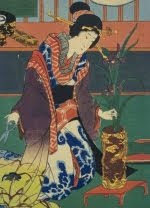Not far from the city centre of Stockholm, Sweden - in the park outside
The Museum of Ethnography, you can enjoy
a genuine tea ceremony in the Japanese tea house named
Zui-Ki-Tei, The Cottage of Auspicious Light. This tea house was built in 1990 as a replacement for an earlier tea house that unfortunately burned to the ground in 1969. This early tea house has an interesting and fascinating history.

In 1888 a young Swedish woman named Ida Trotzig moved to Japan to live with her newly wedded husband who was a Swedish businessman in Kobe. She stayed for more than 30 years, studied Japanese culture and wrote
a book on tea ceremony that was published in Sweden in 1911. She studied for many years with the Omotesenke School of tea.
After publishing her book on tea ceremony she decided to take up ikebana studies and was accepted, probably as the first European, by the Misho school in Kyoto. When she died in 1943, a manusrcipt for a book on ikeabana dating from the 1920s was discovered. She was especially interested in the symbolism and culture of arranging flowers, and the book that was finally published in Swedish in 1990 gives a good insight into ikebana theaching in the early 1900s.
Through the eyes of a westerner, Trotzig experiences the magic of an ikebana exhibition held in the spring of 1915, at Saga Gosho in the old
temple
Daikaku-ji. At first, she writes, the many traditional flower arrangments that were being prepared in front of her eyes looked the same. Only when she looked closer, the many details made each of the arrangemnets uniqe and special.
Trotzig studied thoroughly and got the highest degree of the Misho school that was open to women at this time. Only men could reach the highest levels and the tradition was treated as secret teachings thought trough the different steps.
To Ida Trotzig there was an obvious and close relation between the arranging of flowers and the practice of tea ceremony. After moving back to Sweden she became a driving force behind the building of a
the first teahouse in Europe. This was
the first Zui-Ki-Tei in the garden of The Museum of Ethnography in Stockholm, inaugurated in 1935.
Books:
Ida Trotzig: Japansk blomsterkonst, bokförlaget Signum 1990, ISBN 91-87896-04-4
Gaby Stenberg: Ida Trotzig, min mormor, Japanpionjären, Ellerströms förlag 2009, ISBN 9172472162













